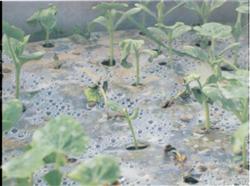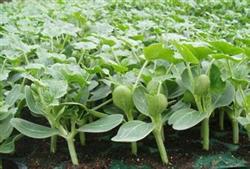Comprehensive Control of Watermelon Seedling Diseases

1. Symptoms of major diseases. 1. Cataplexy. In the initial stage, there is a phenomenon in the root and stem of the seedling (the joint of the root and stem). The disease spot is the same as boiling water, and then the disease part becomes yellowish brown and dry shrinks, the cotyledons have not yet withered, and the seedlings fall to the ground. Most of the quenching disease occurred in the stage from unearthed to 2 true leaves in the seedling cotyledon stage. the disease spread rapidly and caused the seedlings to collapse a few days after the appearance of the central diseased plant. In the case of high temperature and humidity, the disease site of the seedlings and the ground near it, 2. Blight. The newly unearthed cotyledon seedlings and large seedlings could be damaged, and the incidence of large seedlings was higher. There were oval dark brown disease spots on the stem base of diseased seedlings. In the early stage of the disease, the diseased seedlings wilted during the day and recovered at night. When the disease spot developed around the stem, the stem base withered and shrunk, and the plant died, but the seedlings did not fall. The disease department often has light brown arachnoid mold, but it is not obvious, and there is no obvious white floc in the disease department, which can be distinguished from cataplexy. 3. Rust root disease. Rust root disease is also called "retting root". It is a physiological disease. After the seedlings were unearthed, there were no new roots for a long time, and the bark of the young roots was rust-brown and gradually rotted, resulting in aboveground wilting and easy to pull up. Second, the disease condition quenching pathogen is very saprophytic and can survive in the soil for a long time. On the other hand, Rhizoctonia solanacearum can generally survive in the soil for 2mi for 3 years. The pathogen overwintered in the soil and Rhizoctonia solanacearum overwintered in the soil or in the diseased body, and then directly attacked the seedlings. The germs spread through Rain Water, running water, farm tools and bacteria-carrying fertilizers. Long-term overcast and rainy weather, poor light in the seedling bed, too stuffy and humid, low bed temperature and so on are easy to induce sudden collapse disease. Rhizoctonia solanacearum occurs more frequently when the seedling bed has higher humidity and temperature and the seedlings grow excessively. The rust root disease is mainly caused by the low temperature of the seedling bed. If the seedling bed temperature is lower than the critical temperature of seedling growth for a long time (10 °C), the rust root disease is easy to occur. 3. For the prevention and control of watermelon diseases at seedling stage, comprehensive control measures should be taken to strengthen the cultivation and management at seedling stage, supplemented by chemical control. 1. Choose the nursery bed. The seedling bed should be built in a place with high dry terrain, leeward to the sun, good drainage, fertile and loose soil, new soil should be selected for bed soil, and fertilizer for preparing nutritious soil should be fully fermented and mature. 2. Bed soil treatment. More than 50% carbendazim can be used, 810 grams per square meter of medicine. First, mix the medicine with an appropriate amount of fine soil, take 1 big 3 medicinal soil and sprinkle it on the bed surface as cushion soil, and after sowing, use the remaining 2 big 3 medicinal soil as covering soil, or apply the medicinal soil evenly in the tillage layer combined with soil preparation, leaving part of the medicinal soil to cover seed. When treating bed soil with medicine soil, sufficient soil moisture should be maintained to prevent insect pests. 3. Strengthen the management of seedbed. Nursery bed at night to do a good job of heat preservation, to prevent cold wind and low temperature attack, to prevent seedlings from freezing. In the daytime, ventilation should be strengthened to reduce the temperature and humidity of the seedbed so as to make the seedlings grow healthily and improve the disease resistance. Moisture management at seedling stage should be determined according to seedbed humidity and weather surface, and each watering should not be too much to prevent excessive humidity in the bed. It is best to sprinkle a layer of dry fine soil or hay wood ash after each watering to reduce the humidity of the seedbed and preserve moisture. 4. Chemical control. When diseased seedlings are found in the seedbed, they should be removed in time and sprayed immediately to prevent spread. The medicament can be sprayed with copper ammonium mixture of ① 400x (2 parts of copper sulfate, 11 parts of ammonium bicarbonate, fully mixed and sealed for 24 hours, and 1 part of the medicine is dissolved in 400 parts of water) for foliar spraying, spraying every 7 times every 8 days for 3 times, the effect is better. ② 75% chlorothalonil wettable powder. Foliar spraying or rootstock spraying with 1000 times solution or 3000 times solution of dimethazone or 20% Shibao Ling suspension also has better control effect.
- Prev

What problems should be paid attention to in watermelon seedling management?
What problems should be paid attention to in watermelon seedling management? (1) temperature management: in temperature management, two tendencies should be avoided, one is that they do not dare to uncover the film for ventilation, for fear that the seedlings will be frozen, resulting in high temperature and humidity in the seedling bed, causing the seedlings to grow excessively; the other is that the ventilation rate is too large, which makes the temperature in the bed too low, causing the seedlings to grow slowly.
- Next

Four key steps in raising Watermelon seedlings with Hot Kang
The hot Kang seedling of watermelon has the characteristics of fast heating, uniform temperature, low cost, simple operation and so on. Strong watermelon seedlings can be cultivated in January and February when the temperature is very low, and the effect is similar to that of an electric hotbed. First, build a seedbed. First, dig a bed pool that is 4.5 meters long from east to west, 1.6 meters wide from north to south and 0.2 meters deep.
Related
- Moge, come on! The staff of the peasant association in the producing area of cantaloupe were frightened when the crowd gathered.
- Causes and Solutions of low Fruit setting rate of Apple
- Symptoms and control measures of passion fruit virus disease
- Fruit growing lesson: how do apple orchards keep high yields?
- Can you build orchards in the mountains? What are the pros and cons?
- How to manage the coloring period of Crisson grape?
- This paper introduces the processing technology of two kinds of fig products.
- How much is a month for retired teachers in rural areas by 2020?
- How can strawberry planting increase sugar content? We should pay attention to management in many aspects.
- What are the cultivation techniques on how to improve the yield of golden fruit?

